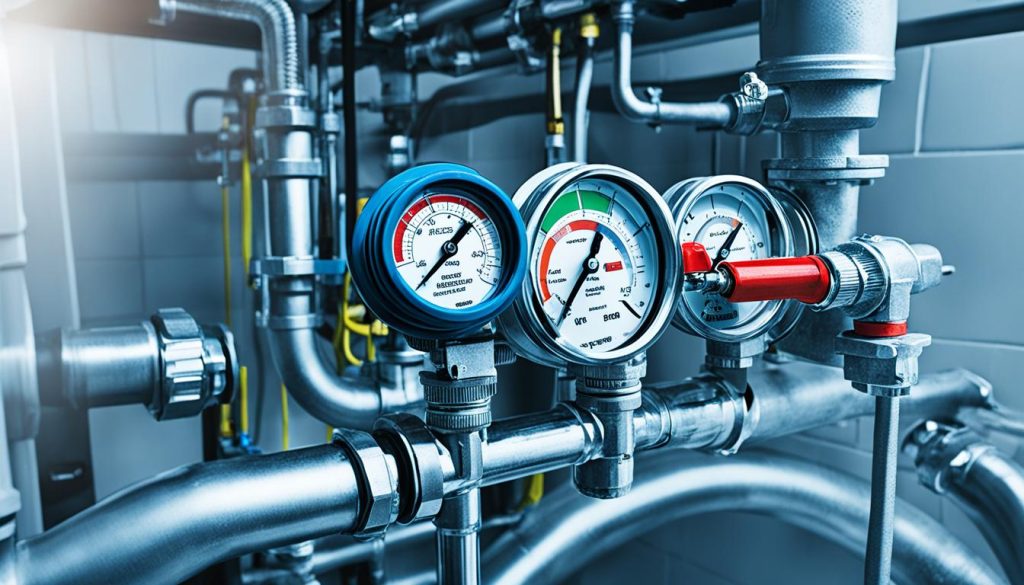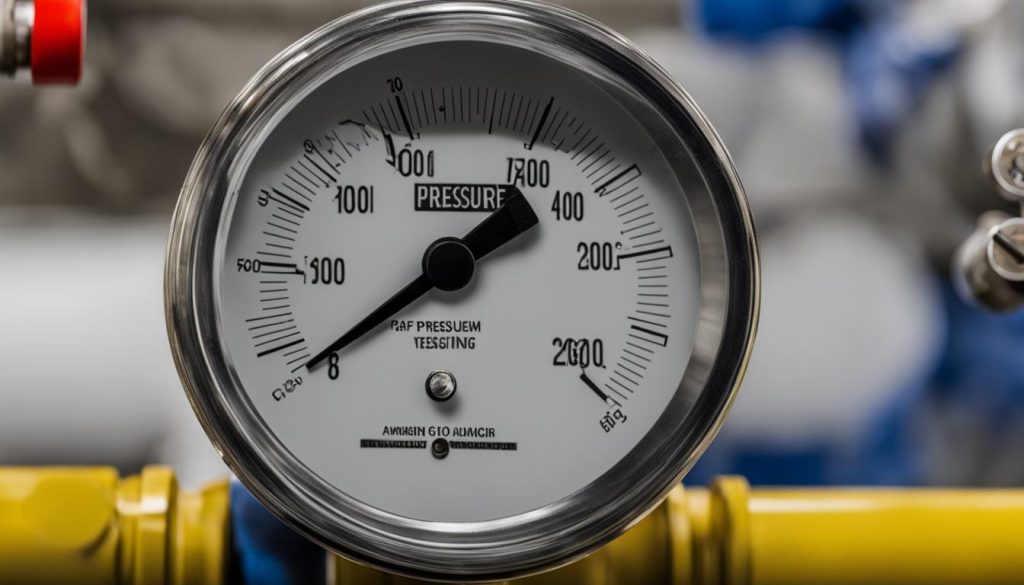Hydrostatic Plumbing Test Cost Explained
If you’re a homeowner, the last thing you want to deal with is a plumbing leak. Not only can it cause significant damage to your property, but it can also cost you a hefty sum to repair. But did you know that a simple hydrostatic plumbing test can help detect these leaks before they become a major problem? And the cost may surprise you.
According to industry experts, the average cost of a hydrostatic plumbing test ranges from $250 to $500. However, for larger plumbing systems, the price can skyrocket to thousands of dollars. This means that investing in a hydrostatic test today can potentially save you thousands of dollars in repair costs down the line.
Key Takeaways
- A hydrostatic plumbing test can help detect leaks in your plumbing system.
- The cost of a hydrostatic test typically ranges from $250 to $500.
- Larger plumbing systems may require higher-priced tests.
- Investing in a hydrostatic test can save you from costly repairs in the future.
- By detecting leaks early, you can prevent further damage to your property.
What is Hydrostatic Testing?
Hydrostatic testing, also known as static testing, is a method used to detect leaks in a plumbing system. It is considered the best method for leak detection, as other methods such as camera inspections are better suited for locating clogs.
During a hydrostatic test, sections of the plumbing are filled with water at a pressure that is up to 1.5 times the pressure limit of the system. Technicians monitor the pressure of the system and manually inspect the plumbing for any leaks. If the water pressure drops during the test, it indicates that there is a leak in the system.
| Advantages of Hydrostatic Testing | Disadvantages of Hydrostatic Testing |
|---|---|
| Highly accurate in detecting leaks | Time-consuming process |
| Localized testing possible | Requires professional expertise |
| Provides comprehensive results | May require system shutdown |
Why is Hydrostatic Testing Important?
Hydrostatic testing plays a crucial role in the due diligence process when purchasing or selling a property. It serves as a reliable method to ensure that the plumbing system is free from leaks and in optimal working condition. Buyers benefit greatly from hydrostatic testing, as it enables them to identify any potential plumbing issues before finalizing the purchase. By detecting these issues beforehand, buyers can avoid costly repairs in the future, resulting in significant savings. On the other hand, sellers can also reap the rewards of hydrostatic testing. By conducting this test, sellers can demonstrate their commitment to maintaining the property, instilling buyer confidence. Additionally, it showcases their due diligence in maintaining the plumbing system, which can positively influence the value and marketability of the property.
The Value of Due Diligence and Property Inspection
Dedicated due diligence and property inspection are essential steps when engaging in real estate transactions. They ensure that buyers are fully aware of any potential issues or risks associated with the property. Completing a hydrostatic test as part of this process provides an in-depth evaluation of the plumbing system, giving buyers a comprehensive perspective on its condition. This detailed inspection helps buyers make informed decisions, protecting their investment and ensuring a smooth transaction.
Signs You Need a Hydrostatic Test
Are you concerned about potential plumbing leaks in your property? Look out for these signs that may indicate the need for a hydrostatic test:
- Discolored water pipes
- Low water pressure
- Visible mold or mildew near pipes
- Unpleasant odors
- Unexplained puddles of water in the yard
- Wet spots on walls or floorboards
- Bubbling paint on walls or ceiling
- Unexplained patches of lush vegetation in the yard
If any of these signs are present, it is recommended to have a hydrostatic test to identify and address any plumbing leaks. This test is the most reliable method for detecting leaks in your property’s plumbing system. By proactively detecting and addressing leaks, you can prevent further damage and potential increases in repair costs.
| Potential Signs of Plumbing Leaks | Explanation |
|---|---|
| Discolored water pipes | This could indicate rust or corrosion and potentially a leak in your plumbing system. |
| Low water pressure | If your water pressure suddenly decreases, it could be a sign of a leak in the pipes. |
| Visible mold or mildew near pipes | Mold and mildew thrive in damp environments, so if you notice them near your pipes, there may be a leak. |
| Unpleasant odors | Musty or foul smells near your plumbing fixtures could be a sign of hidden leaks. |
| Unexplained puddles of water in the yard | If you notice puddles of water in your yard with no apparent source, there may be an underground plumbing leak. |
| Wet spots on walls or floorboards | Moisture on walls or floorboards can indicate a hidden plumbing leak within the walls or under the floors. |
| Bubbling paint on walls or ceiling | Bubbling or peeling paint can be a sign of water damage caused by plumbing leaks. |
| Unexplained patches of lush vegetation in the yard | If certain areas of your yard have unusually lush vegetation, it may be due to an underground plumbing leak providing extra moisture. |
Repairing Plumbing Leaks
If plumbing leaks are detected during a hydrostatic test, repairs will need to be made. To locate the leaks, the plumbing system can be isolated into smaller sections, and each section can be tested individually. Once the leaks are identified, a plumber will need to access the areas to fix them. This can be done through under-slab tunneling or by breaking up the concrete slab from above. It is important to conduct a follow-up test after repairs to ensure that all leaks have been fixed and the plumbing system is leak-free.
Repairing plumbing leaks is a crucial step in maintaining the integrity of your property’s plumbing system. Whether it’s a small leak or a major issue, addressing plumbing leaks promptly is essential to prevent further damage and potential water wastage. The process begins with accurately locating the leaks. By isolating different sections of the plumbing system and testing them individually, plumbers can pinpoint the exact areas that require repair.
Once the leaks are identified, the next step is accessing and fixing them. Depending on the location and severity of the leaks, different methods may be used. Under-slab tunneling is a common approach for fixing leaks beneath the concrete slab of a property. Plumbers create tunnels beneath the slab to access the damaged pipes and make the necessary repairs. Another method involves breaking up the concrete slab from above to access the pipes. Both methods require skilled professionals to ensure precise and effective repairs.
After the repairs have been completed, it is crucial to conduct a follow-up hydrostatic test to ensure that all leaks have been successfully fixed. This test involves repressurizing the plumbing system and inspecting for any remaining leaks. It is a necessary step to verify the integrity of the repairs and ensure that the plumbing system is leak-free. By conducting a follow-up test, you can have peace of mind knowing that your plumbing system is in good working condition.
Repairing plumbing leaks is not only important for the functionality of your plumbing system but also for the overall well-being of your property. Unaddressed leaks can lead to water damage, mold growth, and even structural issues. By promptly repairing leaks, you can prevent further damage and maintain the value of your property. It is advisable to seek professional assistance for plumbing leak repairs to ensure that the job is done correctly and efficiently.
Don’t let plumbing leaks go unnoticed. Addressing them promptly through hydrostatic testing and professional repair services is crucial for maintaining the integrity and efficiency of your plumbing system.
The Cost of Repairing Plumbing Leaks
When it comes to plumbing leaks, addressing them promptly is crucial to prevent further damage and potential increases in repair costs. The cost of repairing plumbing leaks can vary depending on the extent of the damage and the method used for repairs. In some cases, repairs can cost $8,000 to $10,000 or more, making it essential to take action as soon as leaks are detected.
If you’re planning to sell your property, neglecting plumbing leaks can give the buyer leverage to negotiate a lower price. Unrepaired leaks can raise concerns about the overall condition of the plumbing system, potentially affecting the perceived value of the property.
By promptly repairing plumbing leaks, you can protect your investment and avoid costly repairs down the line. Additionally, addressing plumbing issues before selling can instill confidence in potential buyers and demonstrate your commitment to maintaining the property’s integrity.
Remember, leaving plumbing leaks unrepaired not only poses further risks to your property but can also have a negative impact on its value. By taking proactive measures and investing in the necessary repairs, you can ensure that your plumbing system is in good working condition and preserve the value of your property.
The Importance of Fixing Plumbing Leaks
Fixing plumbing leaks is crucial for maintaining the value of a property and ensuring a smooth sale. Leaving plumbing leaks unrepaired can deter potential buyers and give them a negative perception of the property. By fixing the leaks, sellers can demonstrate their commitment to maintaining the property and provide peace of mind to buyers. Additionally, resolving plumbing issues before selling can help protect the property’s value and prevent any potential price reductions during negotiations.
Conclusion
Hydrostatic plumbing tests play a crucial role in property inspections, providing an effective method for detecting and addressing plumbing leaks. While the cost of hydrostatic testing can vary, it is a worthwhile investment to ensure the plumbing system is in optimal working condition. By promptly repairing any leaks that are detected, property owners can prevent further damage and potential decreases in property value.
Addressing plumbing issues is particularly important for sellers who want to increase buyer confidence and protect their investment. A comprehensive hydrostatic test can identify any hidden leaks that could potentially deter prospective buyers. By proactively addressing plumbing leaks, sellers can demonstrate their commitment to maintaining the property and provide peace of mind to potential buyers.
For buyers, a thorough hydrostatic test can help avoid unexpected plumbing repairs and their associated costs. By conducting this test before making a purchase, buyers can gain insight into the true condition of the plumbing system. This knowledge enables them to make informed decisions about the property and negotiate with the seller if necessary.
In summary, hydrostatic plumbing tests are an essential part of property inspections. Investing in this type of test can ensure the plumbing system is leak-free and in good working condition. Whether you are a buyer or a seller, addressing plumbing issues discovered during a hydrostatic test is crucial for maintaining property value and providing peace of mind.
- Investing Wisely: How Windows & Doors in Boost Property Value and Financial Health - April 24, 2025
- The Financial Impact of Personal Injuries: Why Legal Help Matters for Business Owners - April 16, 2025
- The Hidden Financial Costs of Domestic Assault: What Business Owners Need to Know - April 16, 2025













